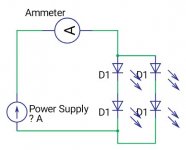i upgraded to LEDs last year. i did know that the light can be bit shaky due to AC/DC conversion.
the lamp has a module of questionable origin with parameters on the output 700mA 34-47V.
is there some other power supply with more stable Voltage you could recommend me?
I am thinking right now about to dismantle some old audio PS and to use it there.
the lamp has a module of questionable origin with parameters on the output 700mA 34-47V.
is there some other power supply with more stable Voltage you could recommend me?
I am thinking right now about to dismantle some old audio PS and to use it there.

LEDs are current driven devices. You want to limit current and not worry too much about the exact voltage (as the required voltage varies).
well in my opinion you want to have a stable power supply. the wire based bulbs stabilize the light output trough inertia of the heat of the wire.
leds in oposite are able to emit changes in the electrical signal much more quicker.
that is why you need a really calm machine. a battery would be ideal.
leds in oposite are able to emit changes in the electrical signal much more quicker.
that is why you need a really calm machine. a battery would be ideal.
LEDs require a stable current source. A small change in voltage through an LED equates to a large change in current. Yes it needs to be stable but it needs to have stable current, not a fixed voltage.
i have only a voltmeter to measure it.LEDs require a stable current source. A small change in voltage through an LED equates to a large change in current. Yes it needs to be stable but it needs to have stable current, not a fixed voltage.
this is how it looks like. i mean just from the visual observation you might think this is cheap shaky China: power supply for a led lamp - Album on Imgur
What you can do is find the nominal voltage for the LED cob, use a fixed DC supply, then you calculate a suitable ballast resistor to limit current to the desired level.
Probably (I didn't look) the cheap supply is not producing DC but chopping line frequency.
Probably (I didn't look) the cheap supply is not producing DC but chopping line frequency.
i measured now the voltage when turned on and shining. 51,5V.
did not manage the Amperes as am not sure about the settings of the device.
did not manage the Amperes as am not sure about the settings of the device.
Just to make sure as I don't know your level of knowledge - current reading needs to be done in series ie. You will need to break the connection.
my meter has but i am have no practice with this. you have to switch the red cable from position mA to 10A... further the lamp blinked once i was measuring i don't want to screw things up.Your meter have a current setting? I would measure that, then you have a good starting point.
what exactly should i setup on the meter to measure ~700mA?
-add yes i have done it in series that was ok...
Set meter to 10a and move the lead
Disconnect one side of the power to the LED module
Put meter in series ie. The disconnected wire to black and the disconnected side of the LED module to red. Best to connect up unpowered and then power on.
Disconnect one side of the power to the LED module
Put meter in series ie. The disconnected wire to black and the disconnected side of the LED module to red. Best to connect up unpowered and then power on.
Fixed intensity LED driver modules provide a constant current across a voltage range. Any flicker if this is the problem or the fear could only be caused by fault in regulation loop or electrolytic capacitors aging.
Variable intensity LED driver of low profile design often uses voltage PWM and thus it often shows flicker, even faintly audible, although frequency is usually high enough to make it less noticeably than common 50/60/100/120Hz flicker.
Variable intensity LED driver of low profile design often uses voltage PWM and thus it often shows flicker, even faintly audible, although frequency is usually high enough to make it less noticeably than common 50/60/100/120Hz flicker.
i could dismantle this and hook up stronger capacitors. this is faulty by design.Fixed intensity LED driver modules provide a constant current across a voltage range. Any flicker if this is the problem or the fear could only be caused by fault in regulation loop or electrolytic capacitors aging.
Variable intensity LED driver of low profile design often uses voltage PWM and thus it often shows flicker, even faintly audible, although frequency is usually high enough to make it less noticeably than common 50/60/100/120Hz flicker.
Why not just buy a new driver from the many offerings? Here are a few:
https://au.rs-online.com/mobile/c/d...ts/led-drivers/?applied-dimensions=4294863860
I don't know what power consumption you need, but those ones are all 700mA output.
https://au.rs-online.com/mobile/c/d...ts/led-drivers/?applied-dimensions=4294863860
I don't know what power consumption you need, but those ones are all 700mA output.
- Home
- Amplifiers
- Power Supplies
- [offtopic] need it for a led lamp.
